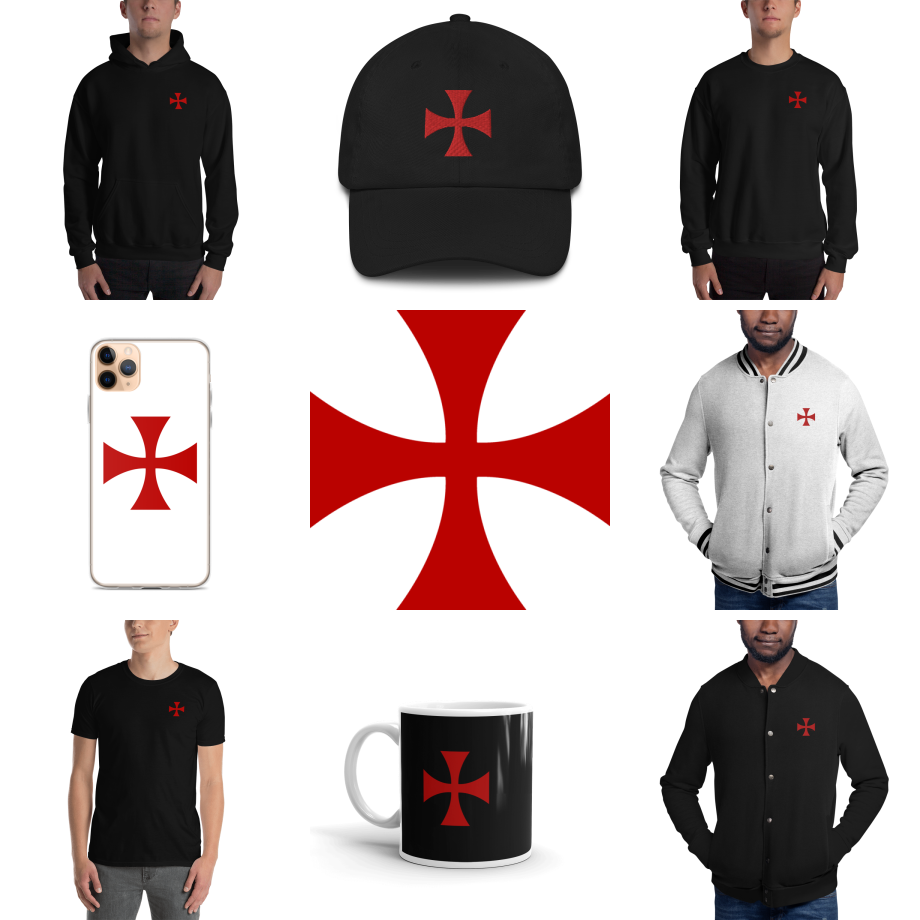Belzoni’s Masonic Manuscript is a fascinating document that sheds light on the history and practices of Freemasonry in the early 19th century.
This manuscript was written by the famous Italian explorer and engineer, Giovanni Belzoni, who is best known for his explorations of Egypt and his discovery of many ancient Egyptian treasures.
Belzoni was a freemason and this manuscript provides an insider’s view of the organization’s practices and beliefs during his time.
The manuscript contains a detailed description of the Masonic initiation ceremony, as well as an explanation of the organization’s symbols and rituals.
One of the most interesting aspects of the manuscript is the description of the Masonic initiation ceremony, which is a ritual that marks a candidate’s entry into the organization.
Belzoni describes the ceremony in great detail, including the use of various symbols and gestures, and the symbolic meaning behind each element of the ceremony.
The manuscript also provides insights into the role that Freemasonry played in society at the time.
Belzoni writes about the various lodges that existed in Europe and the United States, and the importance of the organization in the lives of its members.
He also discusses the charitable works that the organization engaged in, and the ways in which Freemasonry contributed to the social and cultural fabric of the communities in which it operated.
Overall, Belzoni’s Masonic Manuscript is a valuable resource for anyone interested in the history and practices of Freemasonry, as well as for those interested in the broader cultural and social history of the early 19th century.
The manuscript provides a rare glimpse into the inner workings of the organization, and offers insights into its beliefs, values, and practices. It is a fascinating document that continues to captivate and intrigue scholars and freemasons alike.
THE BELZONI MASONIC MSS.
THE history of these highly interesting MSS. is briefly this. They consist of a number of sheets of letter paper bound into two several copies of Belzoni’s celebrated work on Egypt.
They are entirely in the handwriting of Madame Belzoni, and are signed by her “Sarah Belzoni.”
After Belzoni’s death they were presented by his widow to my father, the late Sir William Wilde (Rose Croix, of the original Chapter of Prince Masons, Ireland), shortly after the publication of his ” Narrative of a Voyage to Egypt, Palestine, and Greece, etc.,” in 1840.
Madame Belzoni set great value on the MSS., and they were written by her at her husband’s dictation.
After my father’s death, in 1876, they passed into my possession, and on coming to London I showed them to my friend, Bro. Erasmus Wilson, as one learned in both Masonry and Egyptology, and at his suggestion I have gladly lent them to Bro. A. F. A. Woodford for publication, as they are doubtless of much interest in the Archaeology of Masonry.
I understand, that a MS. similar apparently to these now presented, was published some months ago in the New York Herald. It is most probably that Madame Belzoni had several duplicate copies made of the MSS. (besides the two in my possession), and that one of them found its way to America.
I only wish to state that I never showed the MSS. to anyone before I brought them to Bro. Erasmus Wilson.
The merits and value of the MSS. I willingly leave to other Masons to determine, but I write this note simply to trace their pedigree and guarantee their authenticity.
WILLIAM C. K. WILDE
Grand Master’s Lodge of Ireland, and ” Westminster and Keystone,” England.
1, Ovington Square, S.W., May 20th, 1880.
Giovanni Battista Belzoni

“Giovanni Belzoni.” The Miriam and Ira D. Wallach Division of Art, Prints and Photographs:
Print Collection, The New York Public Library. The New York Public Library Digital Collections.
Giovanni Battista Belzoni (5 November 1778 – 3 December 1823), sometimes known as The Great Belzoni, was a prolific Italian explorer and pioneer archaeologist of Egyptian antiquities.
He is known for his removal to England of the seven-tonne bust of Ramesses II, the clearing of sand from the entrance of the great temple at Abu Simbel, the discovery and documentation of the tomb of Seti I (still sometimes known as “Belzoni’s Tomb“), including the Sarcophagus of Seti I, and the first to penetrate into the Pyramid of Khafre, the second pyramid of the Giza complex.
Sarah Belzoni or Sarah Banne (January 1783 – 12 January 1870) was an English traveller and writer. She met Giovanni Battista Belzoni whom she married in 1813, after which they travelled around England where her husband, who was exceptionally tall, was working as a circus strongman. In 1815 the couple travelled to Egypt.
Source: Wikipedia

“A depiction of Mr and Mrs Belzoni in Egypt. From “The fruits of enterprize exhibited in the travels of Belzoni in Egypt and Nubia”, Lucy Sarah Atkins Wilson, 1822
Print Collection, The New York Public Library. The New York Public Library Digital Collections.
Belzoni was a Freemason but there is little known of his Masonic career. It is known that he visited Norwich in August 1821 when the “Norfolk and Norwich Remembrancer” recorded that:
“Mr. Belzoni, the celebrated traveller and discoverer of Egyptian antiquities, visited Norwich; he stayed with Jeremiah Ives, Esq’ , of St. Catherine’s Hill; previous to his departure he received the high Masonic degree of Knight Templar.”
According to Suffolk Freemasons:
“There are no records of his initiation, but records of Chapter of the School of Plato No.549, Cambridge, record that he was exalted on 14 August 1820.
A jewel he owned was presented by Companion William Stuart, to the Chapter of St. James No. 2, London on 4 March 1869 and to this day, the Belzoni Jewel is worn by the MEZ.”
After Giovanni’s death in 1823, Sarah was in financial straits and utilised her and her late-husband’s experiences and writings in the world of Freemasonry.
She was awarded a sum of fifty pounds from the Benevolent Fund of the United Grand Lodge of England:
“…the United Grand Lodge of Freemasons of England, deeply sympathizing with Mrs. Belzoni, on the irreparable loss which she, as well as the lovers of science and literature, has sustained by the premature death of the late Brother Belzoni, do contribute the sum of 50/. out of the Fund of Benevolence, in aid of the public subscription in her behalf.”
Source: Illustrations of Masonry”, Preston [1855], p.339
The “Manuscript” was also featured in “The Obelisk and Freemasonry According to the Discoveries of Belzoni and Commander Gorringe”, John A. Weisse, New York, 1880

From: “The Obelisk and Freemasonry”, [1880]
Mr. and Mrs. Belzoni…wrote about ancient Egyptian Masonry as they saw it on the walls and monuments.
It may not have been exactly the same, but analogous, as may be realized by these colored and plain illustrations, representing initiations on the walls of the different Mystery Chambers in the splendid rock-excavated Masonic Temple, constructed by Pharaoh Seti I. (Osymandias) and his son, Rameses II. (Sesostris).
The descriptions that accompany the illustrations are opinions Mr. and Mrs. Belzoni formed during and after their sojourn in Egypt.
As Egyptology was in its infancy, and little or nothing was known of hieroglyphic deciphering till about 1825, their ideas can hardly agree with Egyptology of 1880.
The Belzoni manuscripts say so little about the 19th Plate of Belzoni’s Atlas, that we cannot help giving it here by itself and saying, that it speaks for itself, and no Mason can look at the attitudes of this group of Grand Master, Guide, Candidate, and Assistant, without realizing that, if there are Masonic institutions now, there were similar, if not identical ones, about four thousand years ago, in the land of the Pharaohs, and that modern Freemasonry had its prototype in the Masonic Temple of Seti I. and Rameses II, where applicants were initiated as Oriental and Occidental Masonic orders initiate now.
Throughout the thirteen highly ornamented mystery chambers of the Seti and Rameses temple are nine different initiations, little differing from those we give in this epitome.
The position of the hands of the Grand Master here, the right hand of the guide and candidate, as well as the posture of the assistant, look like an initiation to some Masonic degree. In vain will some Masons say these performances belonged to Egyptian religious mysteries.
No one but such as have not attentively looked at them will talk of religious rites and ceremonies.
The attitudes, eyes, and faces of the individuals, the signs, emblems, and symbols around them, indicate anything but religion or devotion.
There is nothing humble, devotional, or prayerful in their countenances or in their postures. The four or five initiatory groupings in the preceding ninth and tenth mystery chambers seem to indicate no religion.
The last one, where the candidate comes before the Grand Master with raised hands, is so well known to Masons that it needs no explanation.
Any brother who will take the trouble to go and see the beautiful illustrations of Belzoni’s discoveries at the Astor Library, or come and look over the series presented to us by Mrs. Belzoni, may realize that the groupings and their surroundings were purely Masonic.
Text of Belzoni’s “Masonic MSS”
DEDICATED TO THE MASONIC BRETHREN UNIVERSALLY
WISDOM was never more exemplified than when it adopted the Pyramidical and Triangular Form from the sublime architecture of the heavens, machined on the firm basis of eternal stability.
The united brethren universally will adopt, I hope, the original form of the Masonic apron, and establish a jubilee to commemorate the restoration of that event, by casting into the flames the present aprons of the unmeaning form of St. Crispin.

The cartouche in the apron of the Pharaoh in this plate has been translated Rameses II., and not Osiris
IMAGE LINKED: wikimedia Attribution 4.0 International (CC BY 4.0)
The plate (above) represents Pharoah Ousirie*, King of Egypt, in Masonic communication with one of that order, whose head is covered with a mask which represents the head of the Ibis; an excellent mode of mystifying.
The king is invested with the triangular Masonic apron, holding in his right hand the grand Masonic emblem and last grade obtained. The second drawing represents the Triangular Apron united with the apron of serpents.
Masonic Signs and Signals originated in the first separation that took place in the family of Adam. From the beginning Cain and his families had ruled with a despotic power over the numerous families of the passive Adam.
The elders and chiefs had been long looking forward for a propitious moment to overthrow the tyrannic power which they had so long been subjected to.
The moment so anxiously hoped for arrived but too soon, in the murder of Abel – Alas, Abel! son of their hopes, in whom they looked for the fulfilment of the promise, destroyed by his brother, the first-born son of their affliction.
From that period discord entered with all its train of evils into the hearts of the human race. A horrible crime had been committed, a dreadful precedent for the unruly and rebellious spirits.
No man felt himself secure from the jealous vengeance of a brother. Suspicion lurked in each eye.
Councils were held by the chiefs of the families, and it was decided that Cain, with his families, should separate and establish themselves at a certain distance from that of Adam, well might the afflicted fratricide exclaim “My punishment is greater than I can bear.”
The murder of Abel was followed by many important events and inventions of necessity, and many things of serious import to the human race were to be arranged previous to the first separation.
From that catastrophe originated the first civil and moral laws established for the general protection.
And it was enacted that disobedience to those laws and regulations were to be punished by death. It was a fearful and momentous epoch to the family of Adam.
Consultations were held among the chiefs, and great must have been their perplexity to invent and arrange a code of signs and signals that the direct descent of each family from Adam might be known to the others in their further wanderings over the globe.
Independent of the general signals, the heads and chiefs invented private signs, sacred among themselves, for a greater security and brotherly love.
Likewise each tribe was invested with a standard or banner as a distinctive attribute, representing certain favourite animals, birds, etc., stuffed and erected on a tree, to be either carried before them or planted before their encampment.
Civil and religious laws, signs, and signals, standards, and banners, were the very first inventions of necessity.
The serpent was the grand standard attached to the family of Abel, or that of Seth, who were invested with universal sovereignty, and to whom was given the birth right of Cain forfeited by the murder of Abel, and in whose family the priestly and monarchical characters were afterwards blended ; and in tire course of time, as religion increased, the serpent was sanctified and adopted as the armorial and sacred emblematic banner of the monarchical and priestly government united.
The mark set upon Cain and his tribes, by which they were to be known by their brethren, was no doubt represented by or on their banners.
The serpent has ever been held by the ancients as the grand mystic emblem of Paradise lost, and was the first hieroglyphic emblematic device, and descended from Seth to the families of Ham and to the kings of Egypt, to be traced in the tombs of that wonderful race.
And the serpent, united with other devices, was the mystic emblem of the tribes of the human race, and spread universally over the known parts of the globe.
THE ROYAL EGYPTIAN MASONIC APRONS
Conservative Freemasonry commenced with creation, established by the family of Seth. The Masonic apron originated from the covering or apron of fig leaves adopted by Adam and Eve after the fall, particularly the mystic apron of serpents, which was dedicated as a memorial to commemorate that fatal event.
The triangular form of the Royal Egyptian Masonic Apron is Masonic, astronomical, and emblematic.
The sun, emblazoned in the corner, spreading its refulgent rays of divine heat and light over the globe.
The king is never represented in this apron alone, it is accompanied always with the mystic apron of serpents, emblematic of the evil spirit under the guise of the serpent that beguiled our fair mother Eve.
The apron of serpents is worn alone on state affairs—emblem of the royal dynasty and symbol of the fall. The triangular apron I consider as a royal order of. the pyramid, to commemorate the occasion for its construction. The triangular and serpent aprons are exclusively royal.
The two aprons appear to have been worn together only on grand Masonic meetings of the hierarchy, whose lodge was in the sacred recesses of a royal tomb; a solemn type of that death denounced on the human race by the wilful transgression of the unborn pair.
A finer emblem could not have been adopted to commemorate that mystic and awful event entailed on their posterity until the final conflagration.
Masonry may be traced in all mythology to the remotest parts of the globe. In the temples of the sun and moon, and in the very idols of Mexico, in the pyramids, temples, Babel, Stonehenge, and in the solemn groves of the Druids.
Masonry shall be traced wherever man is found. Let the Masonic brethren search and they will find that the Egyptian Masonic key will unlock the hitherto unrevealed mysteries of Egyptian wisdom.
THE TOMB OF PHAROAH OUSIREI, KING OP EGYPT, IN THE VAL BEBAN EL MALOOK, THEBES, UPPER EGYPT.
This tomb was the largest and the last of the tombs discovered by the sacrificed traveller, Giovani Batista Belzoni, in 1818.
The above tomb was dedicated to the Masonic mysteries, blended and united with emblems of discoveries, inventions, and sciences in general, progressively as they took place from creation, from which originated the many fabulous inventions that mythology teems with.
Freemasonry in earlier ages was very different from what is now denominated by that appellation, and at the epoch of the above tomb, had attained a grandeur and sublimity unknown in Europe.
Pharoah Ousirei, King of Egypt is represented in the greater part of this tomb as going through the ceremonies of initiation into the sublime mysteries of Masonry, &c, &c, &c. From hieroglyphics, drawings in the said tomb, there appears to be represented three distinct epochs in the life of the young king.
First, on his accession to the kingdom, we behold him going through certain forms and ceremonies, and receiving instructions from the hierarchy in the sciences and secret art of governing.
Having passed his inauguration, and being accepted by the sacred order, I now introduce my young king established, I hope, in all his royal prerogatives.

Giovanni Battista Belzoni (1778-1823) from Plates illustrative of the researches and operations in Egypt and Nubia (1820).
IMAGE LINKED: wikimedia Attribution 4.0 International (CC BY 4.0)
Belzoni’s Atlas, plate the first, represents the king seated on his throne with the mystic apron of serpents, emblem of royalty and symbol of the fall, a sceptre in his hand, incense burning before him.
 The four first hieroglyphics at the back of the eagles are Masonic.
The four first hieroglyphics at the back of the eagles are Masonic.

Giovanni Battista Belzoni (1778-1823) from Plates illustrative of the researches and operations in Egypt and Nubia (1820).
IMAGE LINKED: wikimedia Attribution 4.0 International (CC BY 4.0)
Plate the second —The arms of the nation, blended with the name of the king’s dynasty, offerings, etc., and the spread eagle above, holding in each claw an ostrich feather, an eagle at each side as supporters, holding forth the grand emblem of Masonry, with armorial bearings, grades in Masonry, etc., which forms the three eagles.

Giovanni Battista Belzoni (1778-1823) from Plates illustrative of the researches and operations in Egypt and Nubia (1820).
IMAGE LINKED: wikimedia Attribution 4.0 International (CC BY 4.0)
Plate the third.—The royal name, with winged supporters on each side holding the grand emblem, the name ornamented with globes and feathers, figures kneeling on splendid cushions.

Giovanni Battista Belzoni (1778-1823) from Plates illustrative of the researches and operations in Egypt and Nubia (1820).
IMAGE LINKED: wikimedia Attribution 4.0 International (CC BY 4.0)
Plate the fourth.—Passing certain mystic grades, etc.

Plate the nineteenth.—The High Priest, or Grand Master, or High Grand Master, represented in the temple seated on a throne of state, supported on a platform ; surrounding the base of the platform are the Masonic hieroglyphics, emblems of stability, power, etc., surmounted by winged globes, etc., a serpent attached to it, emblematic of its direful influence over it. A beautiful emblematic border of serpents and globes crowns the whole.
IMAGE LINKED: wikimedia Attribution 4.0 International (CC BY 4.0)
The winged globe is accompanied by the following inscription according to Dr. Young:—
“The sacred Father of the protecting powers Living, unalterable, reigning, ministering.”
In the above temple the king is presented to the High Grand Master by one of that order, his head covered with a mask representing the head of a hawk, denoting his descent, rank, and order, grade, etc., with his right hand gripping the right shoulder of the king, holding in his left the Masonic key.
The female at the side of the Grand Master is one belonging to the hierarchy; she holds the key without the knowledge of its mysterious virtues.
That females were permitted to assist in certain outward forms and ceremonies, processions, etc., is clearly evident.
The king having gone through the whole of the mystic science, we pass with his majesty into the Masonic Hall of Beauties, where his majesty is accompanied by the Masonic order and receives the last and highest grade in Masonry
—the Masonic Key [the Ankh].

In this hall the king is invested with the triangular Masonic apron. In the same hall the king is represented in the act of offering costly vases of perfumed ointments to the female aristocracy there assembled to honour the occasion.
The king is then divested of the triangular and serpent apron while presenting the offerings to the females.
ON THE ORIGIN OF THE LEVEL AND PERPENDICULAR
First employed in the erection of Babylon and Asyria, from which discovery proceeded the words Free Masons, which terms were unknown until some time after the dispersion at Babel.
Nimrod, the royal and mighty hunter, with his vast tribes, had long been master of the lands of Shinar united with the royal herdsman Asshur and his tribes in the strongest bonds of friendship.
The two occupations of hunter and shepherd from the beginning were inseparable, and generally of the same family; the protection of the hunters were most necessary to guard the flocks from beasts of prey, etc.
Esau was a hunter, and Jacob a shepherd. Nimrod and Asshur appear from scripture authority to have been two of the most powerful princes among the unsettled nations; their occupations rendered them of the utmost consequence to the nations round about, and to whom all were tributary.
The confederated princes and sheiks of the unsettled tribes and nations had long contemplated the necessity of a general separation and dispersion over the globe, as the lands could not contain the multitude.
A convention had been entered into by the heads and chiefs of the nation with Nimrod and Asshur, that the united nations should by degrees assemble and encamp on the plains of Shinar for an definitive time, where councils were to be held among the rulers to take into serious consideration the arrangement of the separation and dispersion, Nimrod and Asshur undertaking the supplying the nations with provisions, cattle, beasts of burden, etc., the governments of the nations there assembled agreeing on their part to assist in erecting the kingdoms of Babylon and Assyria for Nimrod and Asshur, etc.
And it was decreed among them that after Babylon was finished, they should, before separating, assist in erecting a monument of gigantic height, as a record to future generations, and to commemorate the name, and descent, and attributes of each nation assembled there, for the express purpose of a general dispersion of the vast multitudes of the younger branches of Noah.
![]()
“Let us build us a city and a tower whose top may reach unto heaven; let ns make us a name, lest we be scattered abroad upon the face of the whole earth.”
Whose top may reach unto heaven. These words alone prove that the plan for building the tower was that of the perpendicular, for hitherto the pyramidal and tent form had been used generally, for the pyramidlike form could never attain or appear high, as its height is lost in the great expanse, and this is what disappoints all travellers on the first view of the pyramids.
The wonderful rapidity with which the kingdoms had been raised by the facility of the level and perpendicular, had caused a great sensation among the rulers of the nations, who were, each anxious to obtain this invaluable secret.
Every stratagem had hitherto been practised to discover it without effect. A few of the chiefs entered into a conspiracy in order to obtain the knowledge of the level and perpendicular, hut deferred it until the Tower of Babel should have attained a certain height, when they would suspend their work.
All had gone on in perfect harmony, and all hitherto were anxious to evince their zeal in ‘this brotherly undertaking, ‘when, alas! “trifles light as air” began to assume a form of hostility.
None but those forming the conspiracy were aware of what was intended, yet all felt that some threatened mischief was at hand, jealously broke forth in all its horrors, and all was anarchy and confusion, which destroyed the well laid plans which had taken many years to arrange in a regular order for the separation, when the royal and noble associates in architecture, and the discoveries of the greatest discovery ever made in science of the level and perpendicular mode of building, were obliged to fly from the fury of malignant jealousy, in order to retain their secret and their lives.
They fled, no doubt, to the nation established by Mizraim, where such talents were sure to be received with royal honours, and to the confusion which took place at Babel are we indebted for the first perpendicular temples of Egypt.
The noble associates had bought their experience dearly, and in order to prevent the monster jealousy from interfering with their grand secret, they consulted with the royal and noble of the nation, and from which consultation a society was formed of the most learned men, who were initiated into the secret of the perpendicular, etc.
Each royal and noble initiated kept a retinue of workers of their own; none were permitted to build who were not of that society.
They travelled in royal style, and each nation they visited added its strength, stability, and power to that fraternity.
Signs and signals were invented, so that the initiated wore known to each other in all lands. These associations were denominated under the title of Royal Freemasons.
From the drawings in the tomb of Pharoah Ousirei proves that Freemasonry from the creation and after the confusion of Babel was perfectly conservative.
SARAH BELZONI Brussels, Oct. 1843.

The Obelisk and Freemasonry
By: John Weisse
Based on the research and writings of the great Italian archaeologist Giovanno Belzoni and the American Naval Officer Henry Gorringe, responsible for the transport of the Egyptian obelisk, “Cleopatra’s Needle”, from Egypt to New York City in 1880, this work makes the assertion that Freemasonry existed well into antiquity.

Narrative of the Operations and Recent Discoveries Within the Pyramids, Temples, Tombs, and Excavations, in Egypt and Nubia
By: Giovanni Battista Belzoni
Giovanni Belzoni proffered this work shyly, explaining that he hoped we would gain from the fidelity of his account. Its truthfulness and its unique capacity to bring us into close proximity with the history of the region. Do not be fooled by his claim that the work is inelegant however. Living in Thebes, the author was able to discern more about the famous tombs than many Europeans of his time. He observed, pried and sweet talked the local population into allowing him to see more than empty tombs and swiftly stashed shovels. He watched the comings and goings from his windows and records social unrest, quarantines and pads through hookah dens and coffee houses. Despite the danger and disease, we defy the reader not to yearn to join him.
Whilst this work has unquestionable historical merit, as a particular kind of primary source, it retains a character and charm that a mere recounting of the facts could not hope to convey. We peek into harems, peer through gates and witness fascinating anthropological events. We see matters of shifting etiquette across the region, attitudes to outsiders, gift customs, marital traditions, examples of defiance and acclimatisation.
The Narrative of the Operations and Recent Discoveries within the Pyramids, Temples, Tombs, and Excavations, in Egypt and Nubia is the story of gentleman archeologist and his observations. Those with any love for biography, tales of long ago and far ago, history, anthropology or the poetry of a description of the sunrise can never be immune to this charming book.
About the Publisher
Forgotten Books publishes hundreds of thousands of rare and classic books.
This book is a reproduction of an important historical work. Forgotten Books uses state-of-the-art technology to digitally reconstruct the work, preserving the original format whilst repairing imperfections present in the aged copy. In rare cases, an imperfection in the original, such as a blemish or missing page, may be replicated in our edition. We do, however, repair the vast majority of imperfections successfully; any imperfections that remain are intentionally left to preserve the state of such historical works. This text has been digitally restored from a historical edition. Some errors may persist, however we consider it worth publishing due to the work’s historical value.
The digital edition of all books may be viewed on our website before purchase.
Recent Articles: manuscripts
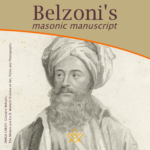 Belzoni's Masonic Manuscript is a valuable resource for anyone interested in the history and practices of Freemasonry, as well as for those interested in the broader cultural and social history of the early 19th century. The manuscript provides a rare glimpse into the inner workings of the organization, and offers insights into its beliefs, values, and practices. It is a fascinating document that continues to captivate and intrigue scholars and freemasons alike. |
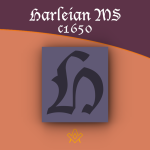 There are two known 'Harleian Manuscripts' which allude to the earliest constitutions of Masonry. |
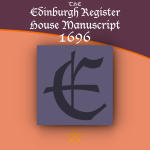 The Edinburgh Register House Manuscript (1696) At the time the manuscript was written in Edinburgh, Scotland was the home to various lodges, including those of the operative Masons of Edinburgh, it provides an interesting Masonic Catechism with questions and answers, a genuine ritual of admission. |
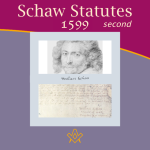 The Second William Schaw Statutes (1599) We look at a modern transcript of the second William Schaw Statutes dated 1599. An operative masons charter for stone cutters and layers in the building industry of the time. A set of rules and regulations including penalties. |
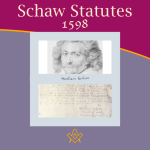 The First William Schaw Statutes (1598) We look at a modern transcript of the first William Schaw Statutes dated 1598. An operative masons charter for stone cutters and layers in the building industry of the time. |
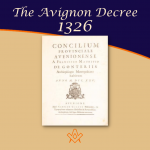 The Avignon Decree (1326) Papal Bull The several Papal declarations against Freemasons after the formation of the Grand lodge in England in 1717 are well known. The Avignon Decree (1326), published 400 years prior, is the earliest known document to set out the Catholic Church's intentions… |
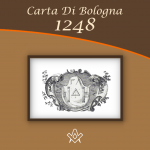 The Bologna Statutes Or Carta Di Bologna The Bologna Statutes or Carta Di Bologna 1248 - Masonic document of Operative Masonry, the oldest one found to date. |
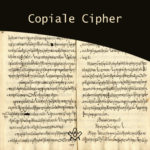 What is the connection between the Copiale Cipher and the great enlightened society of oculists ? |
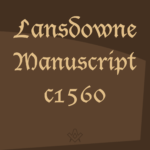 A very foolish legendary account of the origins of the Order of Freemasonry |
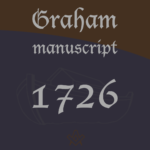 The Graham Manuscript dating from 1726 is an early Masonic document that calls upon Noah and this 3 sons in respect to Masonry, an alternative allegory to the Hiram legend. |
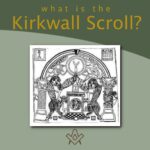 The Kirkwall Scroll is a hand-painted floor cloth depicting a myriad of symbolism |
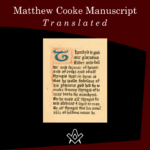 Matthew Cooke Manuscript was written c1450. A transcript of a yet older document, written by a Speculative Mason |
 Are you interested in the 'musty old documents of the past'? This article first appeared in The Builder magazine,1923 |
masonic knowledge
to be a better citizen of the world
share the square with two brothers

click image to open email app on mobile device
